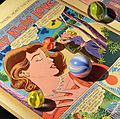Photorealism facts for kids
Photorealism is a cool art style where paintings and drawings look super real, just like a photograph! Artists who use this style try to make every tiny detail perfect. They want their artwork to be so lifelike that you might even mistake it for a photo. This amazing art style first became popular in the 1960s and 1970s.
Contents
What is Photorealism?
Photorealism is a type of art where painters create images that are incredibly detailed. They often use photographs as a guide to make their paintings look exactly like the real world. Imagine drawing a picture of your friend, but making it look so real it's hard to tell if it's a drawing or a photo! That's what photorealist artists aim for.
How Photorealism Started
This art style began in the United States around the late 1960s. It was a reaction to other art styles like Abstract Expressionism, which focused more on feelings and shapes than on realistic images. Photorealist artists wanted to show off their amazing skill and make art that everyone could understand. They often chose everyday things as their subjects, like cars, diners, or city streets.
Key Features of Photorealism
Photorealist paintings have some special qualities.
- Super Detail: Every tiny part of the picture is shown clearly. You can often see reflections, textures, and even small imperfections.
- Sharp Focus: The entire painting is usually in sharp focus, just like a photo taken with a good camera.
- Everyday Subjects: Artists often painted ordinary things. This showed that even simple objects could be beautiful and interesting when painted with such skill.
- Large Scale: Many photorealist paintings are very big. This allows you to see all the incredible details up close.
Famous Photorealist Artists
Two of the most famous artists in the Photorealism movement are Richard Estes and Chuck Close.
- Richard Estes is known for his detailed paintings of city scenes. He often included reflections in windows, making his artworks look even more complex and real.
- Chuck Close became famous for his giant portraits. He would often use a grid system to transfer tiny details from a photograph onto a huge canvas, creating incredibly lifelike faces.
Images for kids
See also
 In Spanish: Fotorrealismo (arte) para niños
In Spanish: Fotorrealismo (arte) para niños




